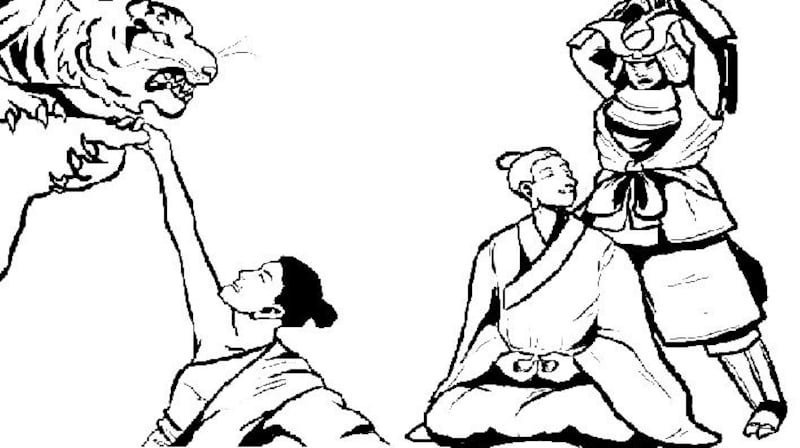In this age of constant opinionating, judgmentalism and mob justice, Garry Bannister is about the most counter-cultural person you’ll meet. Why? Because he espouses an ancient eastern philosophy which values doubt above certainty, and which promotes accepting the world’s problems rather than trying to fix them.
Bannister is a Sligo-born teacher and writer who has been a Buddhist for 35 years, currently practising Nichiren Buddhism – a close cousin of Zen. In his latest book, A Path Home: Conair Siar, he reproduces 41 Zen koans (or wisdom stories) to illuminate this rather challenging way of thinking.
In one classic tale, a Zen master deliberately insults one of his students to illustrate the difference between heaven and hell. As the student’s temper rises (imagine that feeling when you read an annoying tweet), the Zen master declares: “Here open the gates of hell.” As the student becomes peaceful again, he is told: “Here open the gates of heaven.”
“Koans are strange, often counter-intuitive tales that are used to awaken the listener from the pitfalls of habitual thinking and to inspire new insights into the nature of life and death,” Bannister explains.
“If we are interested in such questions as: why are we here, what is reality, who am I, what is enlightenment, is bliss accessible now, then koans are for you.”
The book, ably illustrated by Tania Stokes, a transition year student at St Columba’s College, Dublin, includes a commentary on each story and a poetic composition to help commit it to memory – complete with Irish translations. That might sound like a masochistic exercise to some authors but Bannister says the process was educational.
“More than English, the Irish language is particularly suited to deal with the kinds of ideas that the classical Zen koans are often keen to examine.”

What’s more, he says, exploring the koans through Irish – a language that “is overflowing with mysticism, otherworldliness and allusions to death and suffering” – helped him to appreciate better the similarities between Zen Buddhism and the Irish mindset, such as it is. If Bannister can be believed, there is a little Zen master in each one of us straining to be heard.
The koans can be humorous, absurd and entertaining but is there any logic to them?
"There is no 'logic' to koans," according to Garry Bannister. "Like life they are often unpredictable with messages that transcend both reason and logic. Their modus operandi is to sow doubt and curiosity in our minds and to make uncertainty our ally and guide rather than a worry or a concern.
“There are many interpretations, and an infinite number of ways of reading and understanding the koan tales – all of them equally valid yet frequently clearly contradicting one another.
“And this is to be expected as koans are understood differently depending on where the person is coming from. For example, if you were in Cork and required directions to London, those directions would be different to those given to someone who was living in Glasgow and wished to reach the exact same destination.”
Many of the stories do address common themes, like self-discipline and sacrifice. Is there one moral that stands out?
“What became abundantly clear to me when I started investigating the koans more closely was that there is one fundamental message permeating through a great number of many of the more well-known classical koans and that is the message of non-duality. Non-duality simply means ‘not two’.
“We all have the perception that there is an ‘I’ inside our body and that ‘I’ is looking out at a separate world. In other words, that there is a subject and an object observed by that subject, a knower and a known, a seer and a seen, a hearer and a heard. What many of the koans help to discover is that the knower and the known are, in fact, one and the same. The knower is the subject that knows but can never be known.
“So, therefore, the age-old question ‘If a tree falls in the forest and there’s nobody there to hear it fall, does it then make any noise?’ becomes meaningless. The tree and the knowing of tree, the sound and the hearing of the sound are one and the same thing.”
This kind of non-duality has echoes of environmentalist view that we are ‘one’ with nature. Should Zen Buddhism be seen as an answer to the environmental threat?
“In Buddhist teaching there are eight recommendations to overcome the problem suffering and achieve Nirvana. Two of these are ‘right view’ and ‘right action’. The koans continually point to the realisation that there are no objects in this or any other universe, only relationships. If we change our relationships then the perceived universe around us will also change…
“A very central understanding in all Buddhist practice is that everything is perfect as it is and that we are all perfect as we are. This is one of the hardest Buddhist concepts to grasp, especially when we see all the violence and cruelty happening in the world. But the truth in this statement lies in the realisation that there is, in fact, no ‘other’.
“Borders and boundaries are creations of mind. Migrating birds do not require passports… Everything is a construction of mind. There is no outside or inside, no up no down, no space, no time - but only the perception of these things.
“Finally, we must be careful not to let language or especially any narrative define our thinking or action. If we take, for example, the expression ‘an environmental threat’ we could just as easily say ‘an environmental opportunity’ to make very positive changes in our communities and in the world in general. ‘Turning poison into medicine’ is a basic Buddhist tenet and is a widely encouraged approach to anything that we may perceive as either impure or harmful.”
Many Irish proverbs, or seanfhocail, seem to have a Buddhist flavour. Is traditional Irish wisdom more Zen Buddhist than Christian; more pagan than religious?
“This is a fascinating question and one which might be an excellent topic for doctoral thesis or even a book series.
My gut feeling is that paganism is still very much alive and kicking in Irish tradition today with a very thin cloak of Christianity veiling it
“There are many teachings in Christianity that are extremely close to Buddhist dharma. For example, phrases such as ‘we are all one in the body of Christ’ which could well be interpreted as an allusion to non-duality. When Jesus tells his disciples not to gather up ‘treasures on earth where moth and rush doth corrupt’, his words might be seen by some as making a subtle reference to the transience and impermanence of everything in the universe.
“The phrase that ‘it is better to give than to receive’ is very close to Chogyam Trungpa’s definition of love as ‘fearless generosity’.
“As regards traditional pagan beliefs, here there are many similarities. The most important being is that of the cyclical nature of life. Pagan people were totally dependent of the regularity of the seasons.
“Ireland was a profoundly matricentred society before the arrival of Christianity. For the Celts, all life came from the belly of the earth and the mother was the human manifestation of the life-giver.
“The circular nature of life was traditionally represented by depiction of a serpent and this Celtic serpent can be seen on early Celtic jewellery, ancient stone carvings and the like. The banishing of the ‘snakes’ from Irelands therefore acquires a very symbolic significance in the light of early Irish pagan history.
“Another similarity is the unity that ancient Celts perceived between apparent opposites. For example, darkness or shadow, for the ancient Celts, is an aspect of light. In order to see, there has to be a combination of both light and shadow.
“My personal gut feeling is that paganism is still very much alive and kicking in Irish tradition today with a very thin cloak of Christianity veiling it. The holy wells dotted around the country, the many traditional pagan festivals such as Halloween and tales of the banshee and fairy mounds still abound in folk memory throughout the country. This love of magic and the mysterious is deeply embedded in the Irish psyche.
“Irish people are much more at home in the twilight zone of their imaginations rather than in the everyday and the mundane. And so, Buddhist practices like Nichiren chanting, Zen mindfulness and Shambhala meditation practices would all have a strong appeal to the Irish mindset.”












